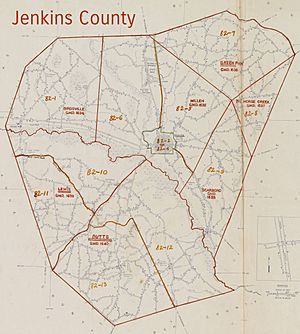Jenkins County, Georgia, riot of 1919 facts for kids
| Part of the Red Summer | |

Census Enumeration District Map Of Jenkins County
|
|
| Date | April 13, 1919 |
|---|---|
| Location | Carswell Grove Baptist Church and Cemetery, Jenkins County, Georgia |
| Participants | White mobs attack the black community |
| Deaths | Official death toll was 6:
|
The Jenkins County riot of 1919 was a terrible event that happened on Sunday, April 13, 1919. It started when some misunderstandings quickly got out of control. This led to two white police officers being killed. In response, groups of white people attacked the local black community. They burned buildings and killed at least four people. This event was part of a larger period of violence called the Red Summer.
Contents
What Led to the Riot?
The trouble began at Carswell Grove Baptist Church. This was a black church celebrating its anniversary. Many people were expected to attend, possibly more than 3,000. It was one of the biggest gatherings in eastern Georgia at the time.
- Preachers from different areas were coming.
- Members of the Knights of Pythias, a black social group, were there in their uniforms.
- The church choir had a special performance planned.
- A big outdoor cookout was going to happen.
Joe Ruffin was an important black farmer and a respected member of the Masons. He was known as one of the richest black men in Jenkins County. He was supposed to help organize the event as a marshal.
How the Riot Started
Joe Ruffin was driving to the church celebration when he had to stop because of all the people. Another car pulled up next to him. Inside were W. Clifford Brown, a sheriff's deputy from Jenkins County, Georgia, and Thomas Stevens, a police marshal from Millen, Georgia. Joe's friend, Edmund Scott, was also in the car, in handcuffs.
The officers were looking for alcohol, which was against the law in Georgia since 1907. They hadn't found any, so they arrested Scott for having a pistol.
The Confrontation
Joe Ruffin offered to pay Scott's bail, which was $400. But Deputy Brown, who was known for having a bad temper, said he needed cash. It was Sunday, so that much cash wasn't available. Brown said he was taking Scott away.
Ruffin reached into the car to try and pull Scott out. Brown then pulled out his gun. He hit Ruffin in the face with the gun. The gun accidentally fired and hit Ruffin on the head, knocking him out.
The Shootings
Joe's son, Louis Ruffin, had just returned from the United States Army. He thought his father had been killed. In response, Louis shot and killed Deputy Brown. More gunshots followed, wounding Marshal Stevens, who was then also killed. Edmund Scott, who was handcuffed in the car, was accidentally killed during the gunfire.
The Mob's Revenge
As news of the killings spread, "hundreds of white men" came to Carswell Grove. Many of them stayed out all night. They burned down the church and Joe Ruffin's car. They also killed two of Ruffin's sons, Henry and John.
- The three black Masonic lodges in Millen were burned.
- White mobs roamed the county for several days.
- The New-York Tribune newspaper reported that seven black churches were burned.
- The Tribune also said that a seventh man was taken from the Millen prison and killed by the mob.
In total, six people died. This included the two white lawmen and four black men: Edmund Scott, Joe Ruffin's sons Henry and John, and Joe's friend Willie Williams. Willie Williams had been at the scene and was also killed by the mob. Joe's son Louis, who shot Deputy Brown, ran away and was never caught, even though there was a reward for him.
Joe Ruffin's Story
Joe Ruffin knew he would be in great danger from the mob. News reports confirmed that he likely would have been killed. He hid, then later gave himself up to Sheriff M. G. Johnston. To keep Ruffin safe, Sheriff Johnston drove him to Augusta, the nearest big city, and put him in jail there.
Seeking Safety
A mob soon headed to Augusta to try and kill Ruffin. So, for his safety, he was moved to a jail in Aiken, South Carolina. He stayed there for two weeks, using a fake name. About 30 people from Georgia came to Aiken, but the jailer told them Ruffin wasn't there, and they believed him.
Ruffin was accused of killing the two officers. No white people were accused of any crimes related to the riot.
Legal Battles
Joe Ruffin hired the best white lawyer he could find. His trial was moved to Savannah. He was first tried for Marshal Stevens' death. He was found guilty and faced a very serious punishment. However, he was granted a new trial and was found not guilty.
He was then tried for Deputy Brown's death and was again found not guilty. Because people in Jenkins County still felt very strongly against him, he was then accused of accidentally causing his friend Scott's death. He was found guilty of unintentionally causing Scott's death and was sentenced to 15 years in prison.
The Georgia Supreme Court later canceled that sentence and ordered another new trial, but it never happened. Because of the strong feelings against him, he couldn't be fully cleared. So, he was accused, found guilty, and fined $500 for misusing church money, even though he never wrote a check. Friends helped him pay the fine, and by 1923, he was a free man.
After paying for all his legal costs, he became very poor. He spent the rest of his life in South Carolina because it was not safe for him to return to Georgia.
See also
 In Spanish: Disturbio del condado de Jenkins de 1919 para niños
In Spanish: Disturbio del condado de Jenkins de 1919 para niños

